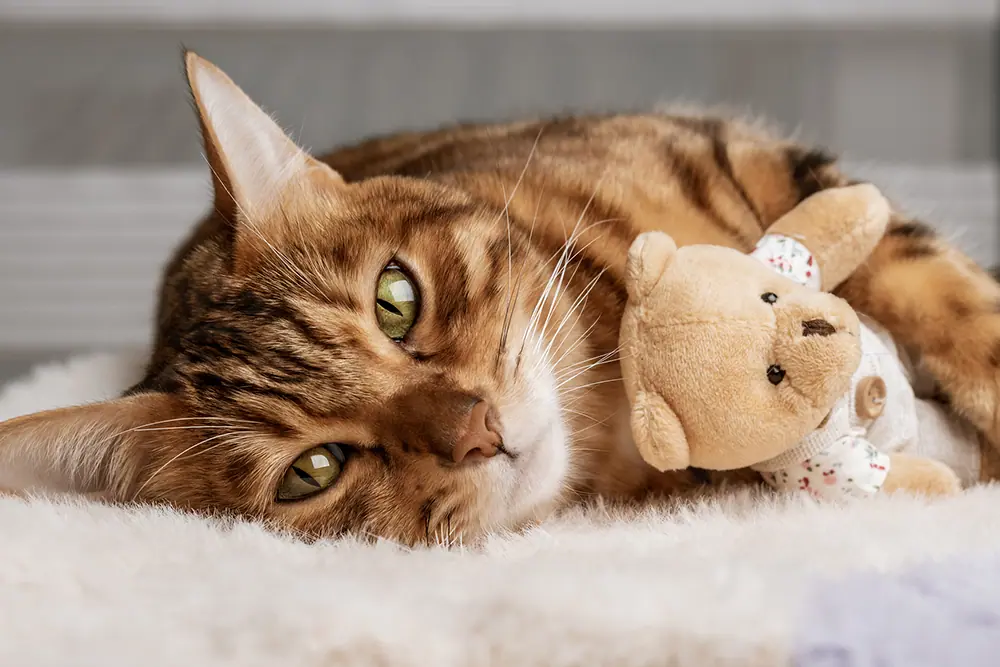As our feline companions age, they may face various health challenges that can impact their quality of life. One common condition that affects cats is osteoarthritis, a degenerative joint disease that can cause discomfort and reduced mobility. In this blog post, we will explore the world of cat osteoarthritis, discussing its symptoms, available treatments, and practical tips to support our beloved cats in managing this condition. By gaining a deeper understanding of cat osteoarthritis, we can provide our feline friends with the care and support they need to live comfortably and happily.
Age and Osteoarthritis in Cats:
Osteoarthritis can develop in cats at any age, but it is more commonly seen in older cats. As cats age, their joints undergo wear and tear, which can contribute to the development of osteoarthritis. While it is more prevalent in senior cats, it’s important to note that osteoarthritis can also occur in younger cats, especially if they have experienced joint injuries or have certain predisposing factors.
Cats are notorious for hiding signs of pain and discomfort, which makes it challenging to identify the early stages of osteoarthritis. However, by being vigilant and observant, we can pick up on subtle changes in their behavior and movement that may indicate the presence of this condition.
If you notice your cat experiencing stiffness, difficulty jumping or climbing, or any other changes in their mobility or behavior, it’s essential to consult with a veterinarian. Early detection and intervention can make a significant difference in managing cat osteoarthritis and improving their overall well-being.
Symptoms of Cat Osteoarthritis and How to Recognize Them:
Cat osteoarthritis can manifest in various ways, and while cats may try to conceal their discomfort, there are several signs to watch out for. Recognizing these symptoms is crucial for early detection and intervention. Here are some common signs of cat osteoarthritis:
- Changes in Mobility: Cats with osteoarthritis may experience difficulty in performing activities they once did with ease. They may exhibit stiffness, reluctance to jump or climb, and reduced agility. You may notice them hesitating before jumping onto surfaces or taking longer to navigate stairs.
- Altered Grooming Habits: Cats are meticulous groomers, but those with osteoarthritis may find it challenging to reach certain parts of their bodies. As a result, you may observe a decline in their grooming routine, leading to a scruffier appearance or matted fur in specific areas.
- Decreased Activity Levels: Cats with osteoarthritis may become less active and engage in fewer play sessions. They may spend more time resting or sleeping, avoiding activities that put strain on their joints. This change in behavior may be subtle but noticeable over time.
- Litter Box Issues: Osteoarthritis can affect a cat’s ability to access the litter box comfortably. They may struggle to enter or exit the litter box, leading to accidents or inappropriate elimination outside the box. If you notice any changes in your cat’s litter box habits, it’s important to investigate the underlying cause.
- Behavioral Changes: Chronic pain associated with osteoarthritis can lead to mood changes in cats. They may become irritable, withdrawn, or exhibit signs of aggression when touched or handled in certain ways. These behavioral changes are often a result of their attempt to protect their painful joints.
It’s important to note that the presence of these symptoms does not definitively confirm cat osteoarthritis. They can also be indicative of other health issues. Consulting with a veterinarian is crucial for an accurate diagnosis. They will perform a thorough physical examination, review your cat’s medical history, and may recommend additional diagnostic tests such as X-rays or joint fluid analysis to confirm the presence of osteoarthritis.
When it comes to managing cat osteoarthritis, a multi-faceted approach is often recommended to alleviate pain, improve mobility, and enhance overall well-being.
Here are some treatment options commonly employed:
- Veterinary Consultation: If you suspect your cat has osteoarthritis, it’s crucial to consult with a veterinarian who specializes in feline health. They will conduct a thorough examination, evaluate your cat’s medical history, and recommend a tailored treatment plan based on the severity of the condition.
- Weight Management: Maintaining a healthy weight is essential for cats with osteoarthritis as excess weight puts additional strain on their joints. Your veterinarian may suggest a weight management program, which may involve portion control, dietary adjustments, and exercise routines tailored to your cat’s needs.
- Pain Management: To alleviate pain and inflammation associated with osteoarthritis, your veterinarian may prescribe pain medications or recommend joint supplements. One such supplement is Essential OMEGAS, an all-natural anti-inflammatory supplement rich in omega-3 fatty acids. This supplement can support joint health and help reduce inflammation. Starting your cat on Essential OMEGAS at a young age can contribute to maintaining their joint health as they age.
- Physical Therapy and Rehabilitation: Physical therapy techniques, including gentle exercise, massage, and hydrotherapy, can help improve joint mobility, muscle strength, and flexibility in cats with osteoarthritis. These therapies can be administered by veterinary professionals trained in rehabilitation techniques.
- Environmental Modifications: Adjusting your cat’s environment can aid in their comfort and mobility. Providing easy access to litter boxes, food, and water bowls, and creating soft and padded resting areas can help minimize stress on their joints.
Additionally, utilizing Cellular BOOST, a supplement that supports cellular health and oxygenation, can enhance your cat’s overall well-being. By improving blood oxygen levels, Cellular BOOST helps optimize nutrient absorption, benefiting not only their joints but their overall health.
It’s important to note that treatment options may vary depending on the individual needs of your cat. Regular check-ups with your veterinarian are crucial to monitor the progression of osteoarthritis and adjust the treatment plan as necessary.
In addition to providing treatment for existing osteoarthritis in cats, incorporating preventive measures into their daily routine can help support their joint health and overall well-being.
Alongside proper veterinary care, here are some preventive measures to consider:
- Balanced Diet: Feeding your cat a balanced diet is crucial for their overall health, including their joint health. Ensure their diet includes high-quality protein, essential vitamins and minerals, and adequate moisture content. Consult with your veterinarian to determine the best diet for your cat’s specific needs.
- Regular Exercise: Engaging your cat in regular exercise helps maintain muscle strength, joint flexibility, and weight management. Interactive play sessions with toys, climbing structures, and gentle exercises recommended by your veterinarian can be beneficial. However, be mindful not to overexert or strain their joints during exercise.
- Joint Supplements: As mentioned earlier, incorporating joint supplements like Essential OMEGAS and Cellular BOOST into your cat’s daily routine can provide additional support for their joint health and overall well-being. Essential OMEGAS, with its anti-inflammatory properties, can help reduce inflammation in the joints, while Cellular BOOST promotes cellular health and nutrient absorption.
- Regular Veterinary Check-ups: Regular visits to the veterinarian are essential for preventive care. Your veterinarian can assess your cat’s joint health, monitor any changes, and provide guidance on preventive measures and adjustments to their care routine.
By incorporating these preventive measures into your cat’s daily routine, you can help reduce the risk of developing osteoarthritis and promote their overall well-being and longevity. Remember to consult with your veterinarian to determine the most appropriate preventive measures based on your cat’s specific needs and health status.
By proactively monitoring and managing cat osteoarthritis, you can significantly enhance your cat’s quality of life. Early detection and ongoing monitoring help ensure that your cat receives the appropriate care and support they need to stay comfortable, active, and engaged in their daily activities.
Remember, as your cat ages, regular check-ups with your veterinarian become even more important. Regular assessments, joint examinations, and discussions about your cat’s behavior and mobility can aid in the early detection of osteoarthritis or any other age-related conditions.
Cat osteoarthritis is a common condition that can significantly impact a cat’s quality of life. By understanding the signs, seeking early veterinary intervention, implementing preventive measures, and monitoring their condition closely, you can ensure that your feline companion receives the necessary care and support to manage osteoarthritis effectively. With proper management and your unwavering dedication, you can help your cat live a comfortable and fulfilling life.




